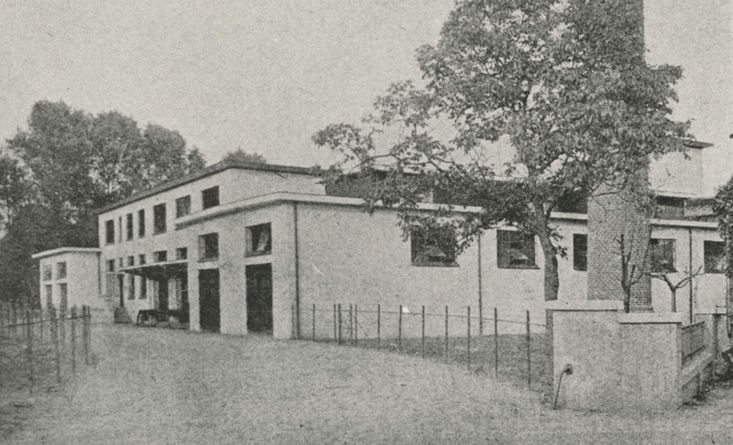EVER CHANGING AREA
Early 1900s
A STORY OF MILK
AND GROWTH
If you were raised in the Netherlands and reading this at eye level, you probably have the world-famous success of the Dutch dairy industry to thank for your long bones – at least, that’s what scientists say! Surprisingly, while the Dutch have always loved milk and cheese, it wasn’t until the early 20th century that the country saw an explosive industrialization of the sector. The first modern dairy factory in Eindhoven was established - not far from where you are standing - in 1917, under the name “Melkinrichting St Joseph”.
1961
THE CAMPINA FACTORY COMPLEX
With the industrialization of Eindhoven, starting in the late 50s, farmhouses in this area were gradually replaced by industrial buildings. In 1961, a large factory complex merged many small, local establishments under the newly coined name Campina – from the Latin name of the region, nowadays known as De Kempen.
The Campina factory produced a large turnover of pasteurized milk, butter, and other dairy products for the industrial market, until, during the 60s, it started to respond to the increasing taste for ice cream from the consumer market. The soaring demand for ice cream and the development of pioneering refrigerating technologies lead to new and more efficient production and distribution practices.
Despite being one of the smaller products in terms of economic scale, Campina Ice cream became a household name throughout the Netherlands. This popularity might be one of the reasons that the name is still part of Royal FrieslandCampina, producing and selling dairy products all over the world.
1969
A POLAR BUNKER
FILLED WITH
ICE CREAM
Due to economic boom during the post-war period ice cream consumption became more and more popular. Campina IJs (Dutch for ice cream) could not stay behind and needed a massive freezer. Campina hired architect H.G.A. Reef and Ingenieursbureau Schiebroek to design the cooling warehouse, officially named “Campina vrieshuis”, and better known to the locals as “het koelhuis”, that is now standing before you as a remarkable example of pragmatism. With about 30.000 m3 storing capacity available across the street, the dairy factory could now increase its production. High volumes of ice cream were stored at -30°C behind the characteristic walls of the building. State-of-the-art freezer trucks would then distribute Campina ice cream across the country and abroad. The pattern of the façade is created by an alternative, vertical use of ‘double-T plates’, flat building blocks normally used horizontally to form platforms and pavements. This created a facade that is completely disconnected from the floors of the building itself, creating a perfect thermal insulation to cool the products.
1980s
THE HEYDAY IS OVER
During the 1980s, many changes happened in the dairy industry, and Campina responded by restructuring and relocating its plants from the area. In 1980, the Campina Ice cream factory went from Eindhoven to Roermond. A freezer warehouse was then built there and the one in Eindhoven became vacant. Around 1994 Campina ice cream was acquired by Nestlé.
Now redundant, the cooling warehouse was gradually dismissed after an honorable career of about 20 years. It was first used as a regular non-refrigerated storage, and eventually left vacant, until it was noticed by squatter communities.
2000s
UNDERGROUND DAYS
In the new millennium, the building, now more and more referred to as ‘Koelhuis’, became a reference point for members of the local underground countercultures.
Where ice cream was once tidily stocked at polar temperatures, now party animals gathered for nightlife events, raves and graffiti art. During these years of intense use, the building got more and more rundown. While it was a cool hotspot for some locals, for others, Koelhuis became a symbol of decadence and shady business.
2017 - Present
PRESERVING
INDUSTRIAL HERITAGE
Koelhuis was ultimately scheduled to be demolished. Eindhoven was about to lose a distinctive landmark, an industrial monument symbolizing the economic heritage of the city. Luckily, the unique profile of this mysterious concrete box inspired Tom Bakkers, an Eindhoven-based real estate entrepreneur, to acquire the building and save it from demolition.
The acquisition of the building was driven by a vision to preserve the building for future generations, honoring its historical role and industrial spirit. Various studies have been made to look for the best purpose of this building for the coming decades. Eventually, Concrete Culture developed a plan to renovate the building into a cultural and tech hub to enhance its value to society. Concrete Culture leverages the generative power of art, culture and tech within real estate development undertakings.
In 2025, Koelhuis, once a forgotten building, officially became a municipal monument. Today, the Koelhuis not only embodies the memory of Eindhoven’sdairy industry but also serves as the heart ofKoelhuis DistrictEindhoven, a cultural and technological hubfocused on immersiveexperiences, media art, and contemporary culture. Known as Brainport’s Immersive Experience District, the area will combine affordable housing, makerspaces, and Koelhuis – the redeveloped large-scale culture and tech hub.






































